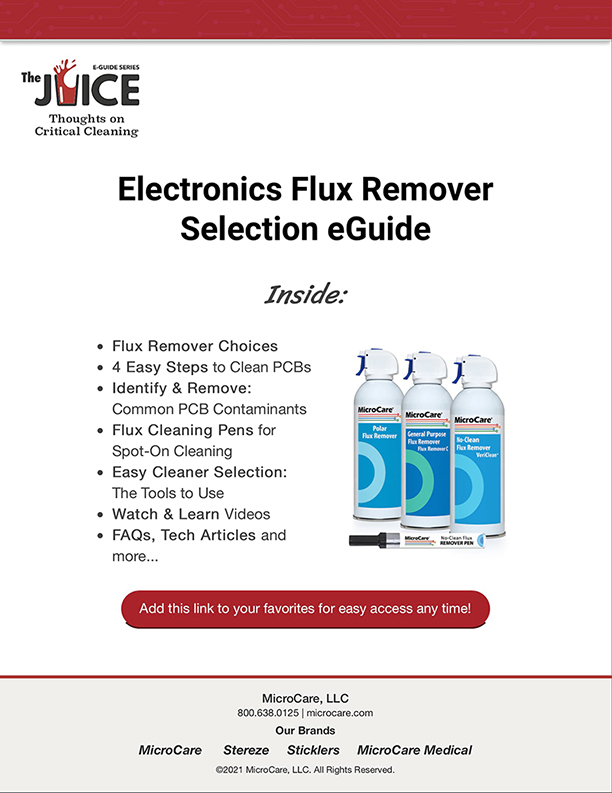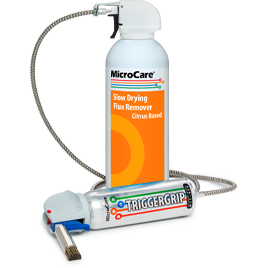Slow-Drying Citrus-Based Flux Remover
Product Information
Sustainable Citrus Flux Remover is made from renewable resources
Applications:
- Cleans flux residue and stencil pastes
- Use PCBs, FR-4 material, stencils, connectors, cables and mechanical assemblies
- Removes inks
- Dissolves many adhesives, except for cured epoxies and cyanoacrylates
- Cleans dirt, moisture, dust and light oxides
- Removes both ionic and organic compounds
- Removes silicone conformal coatings
Features:
- Natural and biodegradable
- No residue / no rinsing
- Strong cleaning strength – test on plastics
- Kb Value: 67 (est.)
- Slow drying time helps drying time helps when cleaning stubborn fluxes
- Pleasant citrus scent
- Chemical Family: Terpene Hydrocarbon
- Flammable (more economical than nonflammable versions)
- VOC Content – 840 g/L
- RoHS/WEEE/ REACH/EPA SNAP compliant
- NSN: 6850-01-549-3821
The Slow-Drying Citrus Flux Remover is a natural, biodegradable, PCB cleaning formulation made with citrus terpenes (not pine) and without surfactants. So, avoids the well-known flammability risks inherent in using old-style pine terpenes near white metals such as aluminum. The cleaner dries slowly, maximizing 'tack time' and minimizing solvent consumption. It has a citrus aroma which is natural and generally non-toxic. But it requires good ventilation. Avoid prolonged skin contact to avoid localized, temporary skin irritation. Neutral pH (not citric acid). The aerosol cans are both TriggerGrip™ Cleaning Tool compatible and StatZAP™ ESD Eliminator Tool compatible.
Product Details
Product Image |
Part Number | Package | Weight | Size | Technical Data Sheet | Safety Data Sheet |
|---|---|---|---|---|---|---|
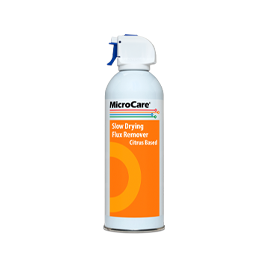
|
EC7M 1613 MCC-EC7M | Aerosol | 0.28 kg 0.61 lb. | 300 ml 10 oz. | ||
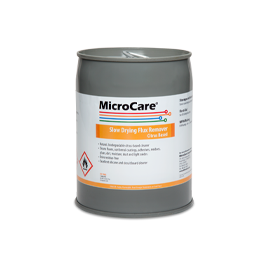
|
EC7MG MCC-EC7MG | Minipail | 2.72 kg 6 lbs. | 3.8 L 1 Gallon | ||

|
EC7MP MCC-EC7MP | Pail | 15.9 kg 35 lbs. | 19 L 5 Gallons | ||
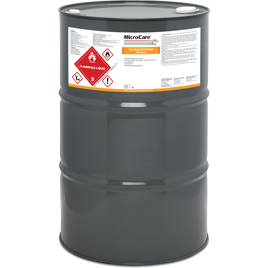
|
EC7MD MCC-EC7MD | Drum | 176.9 kg 390 lbs. | 208 L 55 Gallons |
| Part Number | MCC-EC7M | MCC-EC7MG | MCC-EC7MP | MCC-EC7MD |
|---|---|---|---|---|
| Package | Aerosol | Minipail | Pail | Drum |
| Weight | 0.28 kg 0.61 lb. | 2.72 kg 6 lbs. | 15.9 kg 35 lbs. | 176.9 kg 390 lbs. |
| Size | 300 ml 10 oz. | 3.8 L 1 Gallon | 19 L 5 Gallons | 208 L 55 Gallons |
| Technical Data Sheet | ||||
| Safety Data Sheet |
Scroll
| Appearance | Clean, colorless liquid |
|---|---|
| Odor | Citrus |
| PEL (ppm, 8-hr TWA) | No Toxicity Rating Assigned (GRAS) |
| Boiling Point | 169-187°C / 340-372°F |
| Chemical Family | Terpene Hydrocarbon |
| Evaporation Rate | Slow |
| Cleaning Strength (Kb) | 67 |
| Active Ingredients | Citrus Terpenes |
| Flashpoint | 47˚C / 117˚F |
| Global Warming Rating (100yr) | Zero |
| VOC Organic Content (g/L) | 840 |
| Ozone Impact | 0 |
| REACH & ELINCS Compliant | |
| RoHS & WEEE Compliant | |
| Safety Rating | Flammable |
| Specific Gravity | 0.84 |
| Surface Tension | 26.0 |
| Viscosity | 0.8 |
| Vapor Pressure @ 20ºC | 0.21 |
- Which Cleaner is Best at Removing Silicones?
- Which MicroCare Products Meet Mil-spec Cleaning Requirements?
- Do I Need Gloves When Working With MicroCare Cleaners?
- My People Are Complaining About Solvent Fumes. What Can I Do?
- Are There Any IPA Replacement Cleaners?
- What’s the Best Way to Dry a PCB on the Benchtop?
- How Do PCB Cleaning Pens Work?
- How Do I Choose a Contact Cleaner?
- What are the Benefits of Better Quality Stencil Rolls?
- Any NSN Numbers Assigned to MicroCare Cleaning Products?
- Which MicroCare Aerosol Cleaner is the Strongest?
- How Do I Clean Fiber Optic Components on PCB Circuit Cards?
- What's a TriggerGrip™ and How Does It Help Me?
- What's the Best Way to Clean PCBs at the Benchtop?
- Is Dip-and-Brush Cleaning Good for Cleaning Circuit Boards?
- How Can I Cost-Justify the Trigger Grip System?
- How Do I Use the TriggerGrip™ System?
- How Long Will A TriggerGrip™ Last?
- Why Does MicroCare Have So Many Different Benchtop Cleaning Choices?
- How Long Does a Can of MicroCare Flux Remover Solvent Last?
- How Long Does a Can of MicroCare Cleaning Fluid Last?
- My StatZap™ No Longer Fits on My Micro•Blast™ or Big•Blast™ -- What's Up With That?
- Which Cleaner Works Best on Lead-Free Fluxes and Pastes?
- What's Best for Cleaning RMA Fluxes and Pastes?
- What's the Best Cleaner for 'No Clean' Solders and Pastes?
- Why Should I Clean 'No Clean' Fluxes and Pastes? Can I Just Skip the Cleaning and Save Some Money?
- Which Is the Mildest MicroCare Cleaner?
- Which Cleaner is Best at Removing Conformal Coatings?
- What Can I Use to Clean Computer Keyboards, Cabinets and Housings?
- What Cleaner Can I use for Removing Marking Inks, Sharpie Inks and Pen Ink?
- Which Cleaner Is the Best to Remove HumiSeal 1B31 (Acrylic Conformal Coating)?
- How Can I Remove Toner Off Laser Printers and Copiers?
- Which Cleaner Works Best on Light Grease, Oils and Other Lubricants?
- Which Cleaner Works Best on OA Fluxes and Pastes?
- Which Flux Remover Is Best on Ceramic Hybrid Circuits?
- Which Is the Best SMT Stencil Cleaner?
- Which Cleaner Is Best to Use in Automated Stencil Printers?
- What's Best for Cleaning Under Low Clearance SMT Components?
- Which Cleaners Work Best in Ultrasonic Tanks or Dip Tanks?
- Are MicroCare Products Approved for Use in Clean Rooms?
- What Can I Use to Clean the Burned-On Fluxes in My Reflow Ovens and Wave Solder Machines?
- What Cleans Soldering Pallets and Frames?
- What is Causing White Residue on my PCBs?
- Is There a Cleaning Process to Remove Residues and Build-Ups on Wave Solder Machine Pallets?
- How Can I Heat the Reflow Oven Cleaner to Use in a Dip Tank?
- How Do I Dispose Empty Aerosol Cans and Pump Spray Bottles?
- How Can I Clean a Spray Fluxer in a Wave Solder Machine?
- Does MicroCare Have Any Replacements for HCFC-225?
- What's the Best Replacement for nPB Aerosols?
- Can I Get HCFC-141b Alternatives for Cleaning?
- Are MicroCare Products Safe or Hazardous?
- Are Any MicroCare Products Nonflammable?
- Do Flammable Cleaners Create a Hazard on the Rework Bench?
- Are There Toxicity Issues with Trans?
- How Can I Ensure My People Are Handling Chemicals Properly?
- What Are the NFPA Ratings for the MicroCare Cleaners?
- What's the Shelf Life of MicroCare™ Cleaners?
- What Is the VOC Content of the MicroCare Flux Removers?
- What Are VOCs? Which MicroCare Products Contain VOCs?
- Which MicroCare Cleaners Contain VOCs?
- What Does It Mean to Be 'VOC Exempt'? Is the Chemical Still a VOC?
- Is Global Warming a Problem With Any MicroCare Products?
- Do MicroCare Aerosol Products Damage the Ozone Layer?
- Can I Get Refills for My Presaturated Wipes?
- Does MicroCare Sell Freeze Sprays and Dusters ('Canned Air')?
- What Flat Wipes (Lint-Free Dry Wipes) Does MicroCare Offer?
- What Can I Use to Clean Manual Stencil Printers?
- Are MicroCare Wipes ESD-Safe?
- What Is the Liquid Quantity of Cleaner in a MicroCare Package?
- Can I Get Stencil Wiping Rolls from MicroCare?
- What Is MicroWipe™ FP Stencil Wiping Paper?
- Does the Paper Quality on a Stencil Roll Make a Difference?
- What Are the Benefits of Choosing MicroWipe™ FP Paper Over Ordinary Stencil Rolls?
- What's the Technology Behind the SMT Printing Quality Improvements from FP Stencil Rolls?
- How Does the Vacuum Feature Affect My Paper Choice?
- Can I Get Stencil Wiping Rolls in Custom Sizes?
- Does MicroCare Have Competitive Stencil Roll Pricing?
- Do MicroCare Cleaners Meet the F-Gas Rules in Europe?
- Is MicroCare REACH Registered? Which Cleaners Can I Use in Europe?
- Which MicroCare Cleaners Can I Use in Australia?
- Which MicroCare Cleaners Can Be Used in Japan?
- Which Cleaners Can be Used in California?
- How Do I Measure PCB Cleaning Results?
- What's a 'Wetting Index' and Why Is It Important In Cleaning?
- What Does 'Hygroscopic' Mean? Why Is It Important?
- What Is a Kb Value? What Does It Tell Me About My Cleaning Fluid?
- What Is a Toxicity Rating (PEL, TLV, AEL)? Which Solvent Is the Safest (Has the Least Toxicity)?
- What is an Azeotrope? Why Are They Important?
- Azeotropes Explained
- Our Chemistries and Expertise Set Us Apart - APEX 2020 Interview
- Solder Paste and Flux Cleaning Results Revealed
- Cost-Cutter: Seven Ways to Save Money Cleaning PCBs
- How-to Connect and Disconnect the TriggerGrip Cleaning Tool
- How-to: Using the TriggerGrip PCB Cleaning Tool
- Best Practices: Cleaning During PCB Rework and Repair
- MicroCare Partners in RENEX Hand Soldering Championship 2019
- Mike’s Radio Repair Demonstrates the TriggerGrip™ Cleaning System
- Jumbo Sized Flux Removers Save Money
- Portable Flux Remover Pens are a Convenient Time Saver
- Static Dissipative Wipes Clean Without Worry
- Cost Saving Products for Benchtop Cleaning
- Case Study #15 — Cleaning Mixed Flux Residues from PCBs
- Going Green with Vapor Degreasing
- MicroCare Leads the Way on Worker Safety and Regulatory Compliance
- MicroCare Lab Services for Critical Cleaning
- MicroCare Critical Cleaning Experts
- The MicroCare Reliable Care Way
- 4 Types of PCB Contamination and How to Remove Them
- An Early PCB Cleaning Plan Leads to Manufacturing Success
- Cleaning and Drying Before Conformal Coating: Why It’s Important
- MicroCare Offers IPA Alternative Cleaners
- Modern Electronics Require Updated Cleaning Methods
- Modern PCBA Cleaning: Methods to Improve Reliability
- Removing PCB Conformal Coatings
- Use Toxicity Ratings to Help Ensure Worker Safety
- The Meaning of Kb Value in PCB Cleaning
- Why Clean a No Clean Flux
- TriggerGrip InfoGraphic
- Flux Remover Selection Guide
- The Importance of Drying in PCB Cleaning
- Ensure Contact Cleaner Compatibility with Today’s Complex Electronics
- All Electronics Cleaning Wipes Are Not Created Equal
- Safer Cleaning Choices Replace nPB in Aerosols for Worker Safety
- Circuit Board Design & Cleaning Evolves to Support Down-Hole Logging Technologies
- Stencil Wiping Fabric Improves Stencil Printer Through-Put

